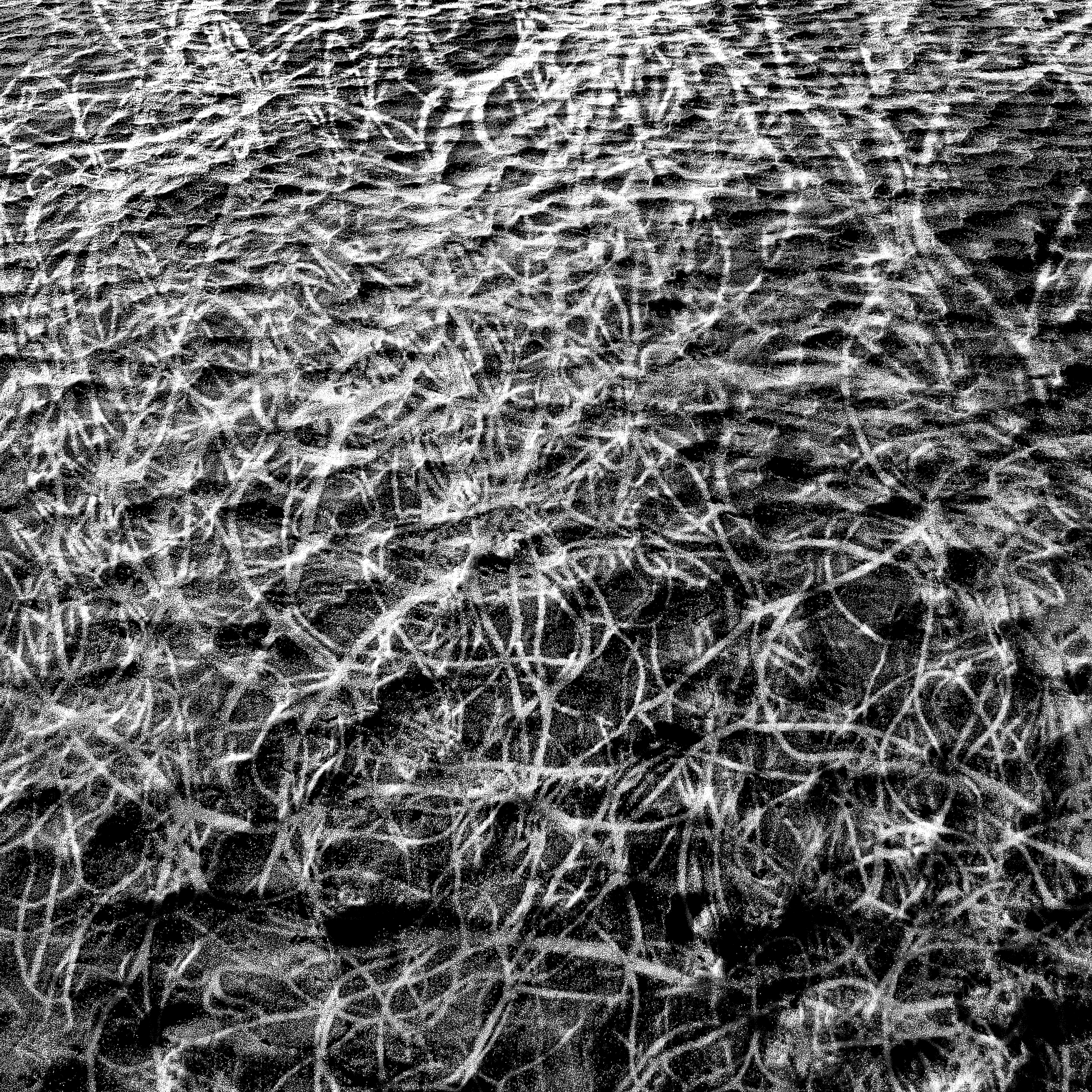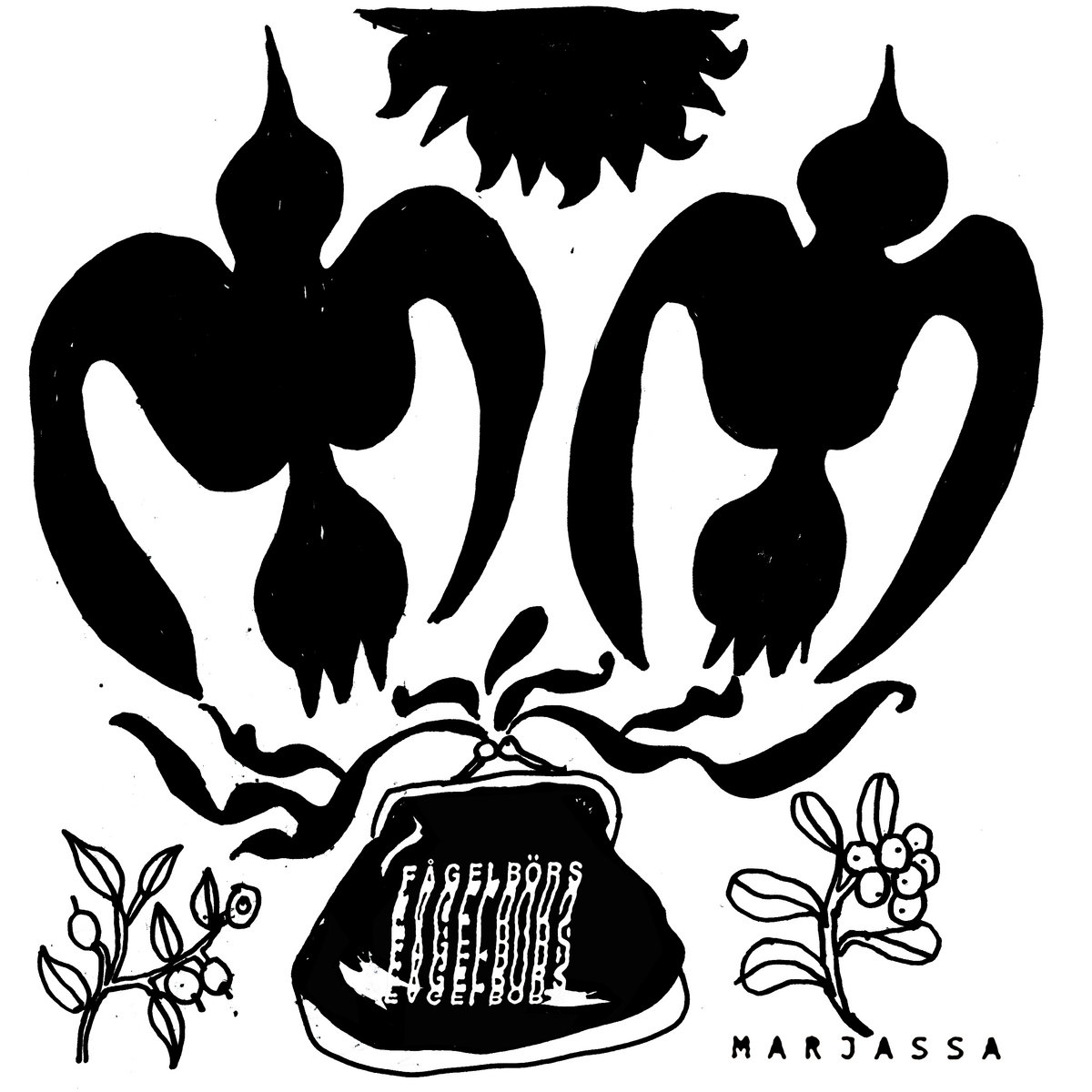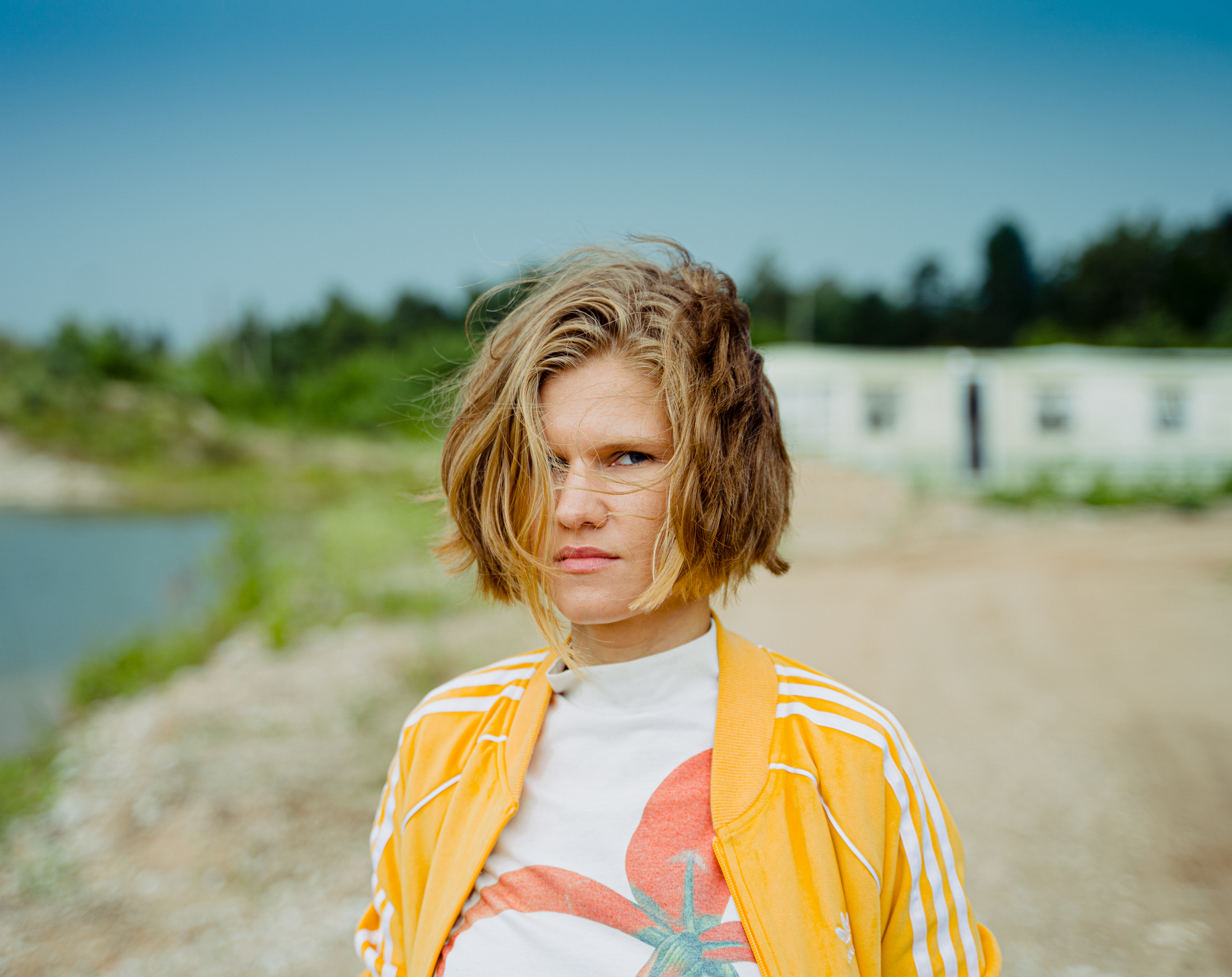
Maarja Nuut
︎ https://maarjanuut.bandcamp.com ︎︎︎
Maarja Nuut is a singer, violinist, electronic artist, and composer whose work spans a vast range of rich musical worlds. Classically trained and an alumnus of several prestigious music institutions, she’s since delved into a number of disparate genres: Hindustani classical music while studying in New Delhi, Estonian archive sounds and dance, ethnomusicological research, and, more recently, the outer limits of looping and electronic sounds. Fuelled by her instincts and curiosity, such exploration comes from an inner need, and a desire to probe each world’s musical language, techniques, and expressional qualities – elements she swirls into her own, mesmerising art.
Restlessly creative, Nuut has always been interested in storytelling and what the past can tell us about the future; for her, myths provide connection points to the modern world and societal upheaval. Since the release of her solo record ‘Une Meeles’ in 2016, she’s received widespread critical acclaim alongside numerous awards, and has toured the world several times over as a solo performer. Known for her compelling, often hypnotic live performances, she’s also collaborated with a number of artists such as Sun Araw, the Estonian Chamber Choir Sireen, Kristjan Järvi, Kiya Tabassian and Hendrik Kaljujärv AKA Ruum among others.
Maarja’s third solo album ‘Hinged’, released in August 2021 received widespread critical acclaim while being called one of Europe’s most innovative musical artists, always looking to dive deeper (Future Music).
Photo (C): Taavi Arus
All Artists︎︎︎

Helena Pulkkinen
︎soundcloud︎︎︎
..........Locating, relocating through voice and digitally cut stories
Helena Pulkkinen released a debut EP ’When they go under, how they navigate’ in 2020 with World Canvas label. At the moment they are preparing some new music and a fictional sound story. SOLA festival’s performance will be premiering some of these sounds.
All Artists︎︎︎

Daïchi Saïto
Originally from Japan, Daïchi Saïto is a filmmaker based in Montreal, where he co-founded the artist film collective Double Negative. His film Trees of Syntax, Leaves of Axis (2009) was named one of the "150 Essential Works in Canadian Cinema History" by Toronto International Film Festival in 2016. At Rotterdam, Saïto won a Tiger Award for Short Film with Engram of Returning (2015). His book of short prose Moving the Sleeping Images of Things Towards the Light is available from Le laps in Montreal.
Chiasmus (2003 / 16mm / b&w / sound / 1S / 8' 00)
An exploration into perceptual processes in the act of seeing and listening, Chiasmus takes film as a metaphor for the breathing body, through the intercrossing of the medium and the fragmented images of the body in movement. The rhythm and tension created by the interplay between sound and image, and their disjunction and conjunction, aspire to an organic and sensual moment where inside becomes outside, and outside inside.
An exploration into perceptual processes in the act of seeing and listening, Chiasmus takes film as a metaphor for the breathing body, through the intercrossing of the medium and the fragmented images of the body in movement. The rhythm and tension created by the interplay between sound and image, and their disjunction and conjunction, aspire to an organic and sensual moment where inside becomes outside, and outside inside.

Trees of Syntax, Leaves of Axis (2009 / 35mm / color / sound / 1S / 10' 00)
Sound (violin): Malcolm Goldstein (original structured improvisation score “Hues of the Spectrum”)
Trees of Syntax, Leaves of Axis is Saïto's second collaboration, after All That Rises, with composer/violinist Malcolm Goldstein, who composed and performed for the film the original structured improvisation score, Hues of the Spectrum. The film explores familiar landscape imagery Saïto and Goldstein share in their neighbourhood at the foot of Mount-Royal Park in Montréal, Canada. Using the images of maple trees in the park as main visual motif, Saïto creates a film in which the formations of the trees and their subtle interrelation with the space around them act as an agent to transform viewer’s sensorial perception of the space portrayed. Entirely hand-processed by the filmmaker, Trees of Syntax, Leaves of Axis, with the contrapuntal violin by Goldstein, is a poem of vision and sounding that seeks certain perceptual insight and revelation through a syntactical structure based on patterns, variations and repetition.
Sound (violin): Malcolm Goldstein (original structured improvisation score “Hues of the Spectrum”)
Trees of Syntax, Leaves of Axis is Saïto's second collaboration, after All That Rises, with composer/violinist Malcolm Goldstein, who composed and performed for the film the original structured improvisation score, Hues of the Spectrum. The film explores familiar landscape imagery Saïto and Goldstein share in their neighbourhood at the foot of Mount-Royal Park in Montréal, Canada. Using the images of maple trees in the park as main visual motif, Saïto creates a film in which the formations of the trees and their subtle interrelation with the space around them act as an agent to transform viewer’s sensorial perception of the space portrayed. Entirely hand-processed by the filmmaker, Trees of Syntax, Leaves of Axis, with the contrapuntal violin by Goldstein, is a poem of vision and sounding that seeks certain perceptual insight and revelation through a syntactical structure based on patterns, variations and repetition.
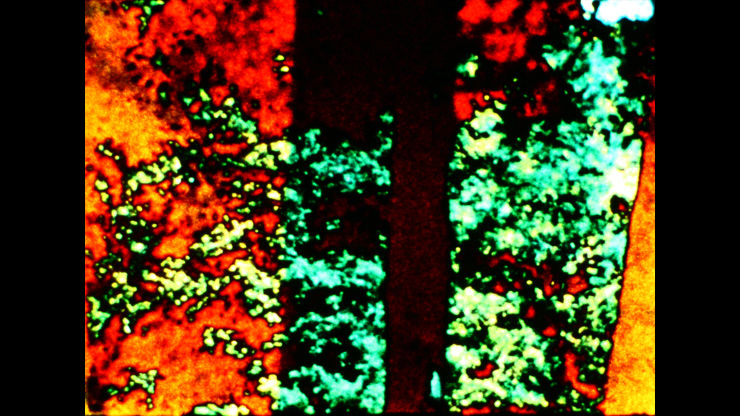
Never A Foot Too Far, Even (2012 / 16mm / color / sound / 2S / 14' 00) double-projection
Appropriating a brief fragment from a 35mm print of an old Kung Fu movie, Never a Foot Too Far, Even is an action movie without action. Presented in double-projection, with images from two separate rolls overlaid to form a single image, this film focuses on an obscure figure finding himself in a forest path, caught between perpetual motion and stasis. The painterly images fluctuate in the complex shifting of color and texture, phasing in and out through a polymetric structure. It is a perceptual journey without destination in the turning sphere of ever-changing image and sound, whose beginning and end move in parallel towards a fleeting point of convergence. The palindrome of the title alludes to the structure of the film based on various combinations of a series of recurring sequences that move forward and in reverse simultaneously, defying the usual sense of progression. With original sound composition by Malcolm Goldstein.
Appropriating a brief fragment from a 35mm print of an old Kung Fu movie, Never a Foot Too Far, Even is an action movie without action. Presented in double-projection, with images from two separate rolls overlaid to form a single image, this film focuses on an obscure figure finding himself in a forest path, caught between perpetual motion and stasis. The painterly images fluctuate in the complex shifting of color and texture, phasing in and out through a polymetric structure. It is a perceptual journey without destination in the turning sphere of ever-changing image and sound, whose beginning and end move in parallel towards a fleeting point of convergence. The palindrome of the title alludes to the structure of the film based on various combinations of a series of recurring sequences that move forward and in reverse simultaneously, defying the usual sense of progression. With original sound composition by Malcolm Goldstein.
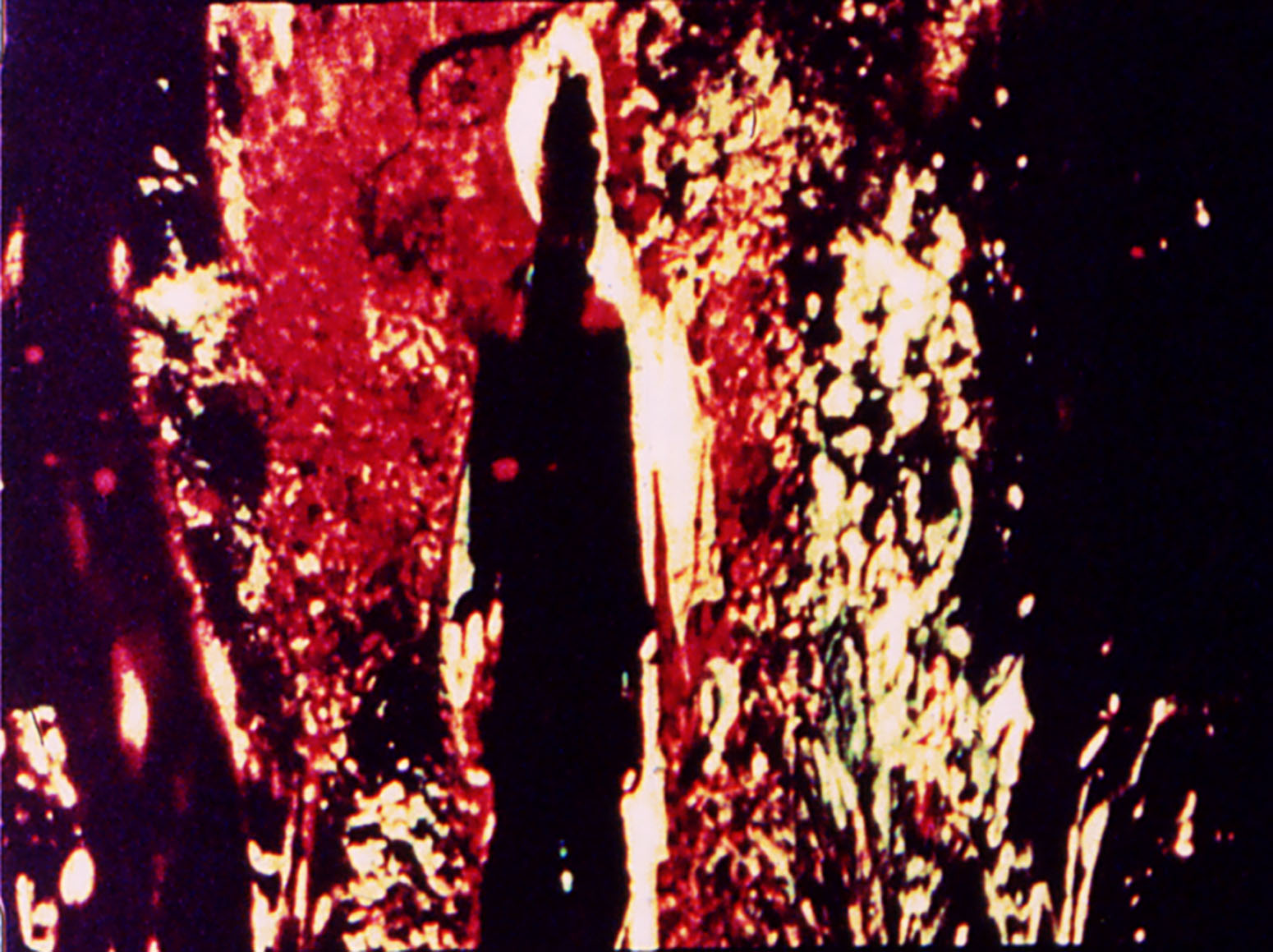
Engram of Returning (2015 / 35mm / color / sound / 1S / 18' 30)
“The figure of the jig-saw / that is of picture, / the representation of a world as ours / in a complex patterning of color in light and shadows, / masses with hints of densities and distances, / cut across by a second, discrete pattern / in which we perceive on qualities of fitting and not fitting / and suggestions of rhyme / in ways of fitting and not fitting – / this jig-saw conformation of patterns / of different orders, / of a pattern of apparent reality / in which the picture we are working to bring out appears / and of a pattern of loss and of finding / that so compels us that we are entirely engrossed in working it out, / this picture that must be put together / takes over mere seeing.”
– from "Kopoltus" Robert Duncan
“The figure of the jig-saw / that is of picture, / the representation of a world as ours / in a complex patterning of color in light and shadows, / masses with hints of densities and distances, / cut across by a second, discrete pattern / in which we perceive on qualities of fitting and not fitting / and suggestions of rhyme / in ways of fitting and not fitting – / this jig-saw conformation of patterns / of different orders, / of a pattern of apparent reality / in which the picture we are working to bring out appears / and of a pattern of loss and of finding / that so compels us that we are entirely engrossed in working it out, / this picture that must be put together / takes over mere seeing.”
– from "Kopoltus" Robert Duncan
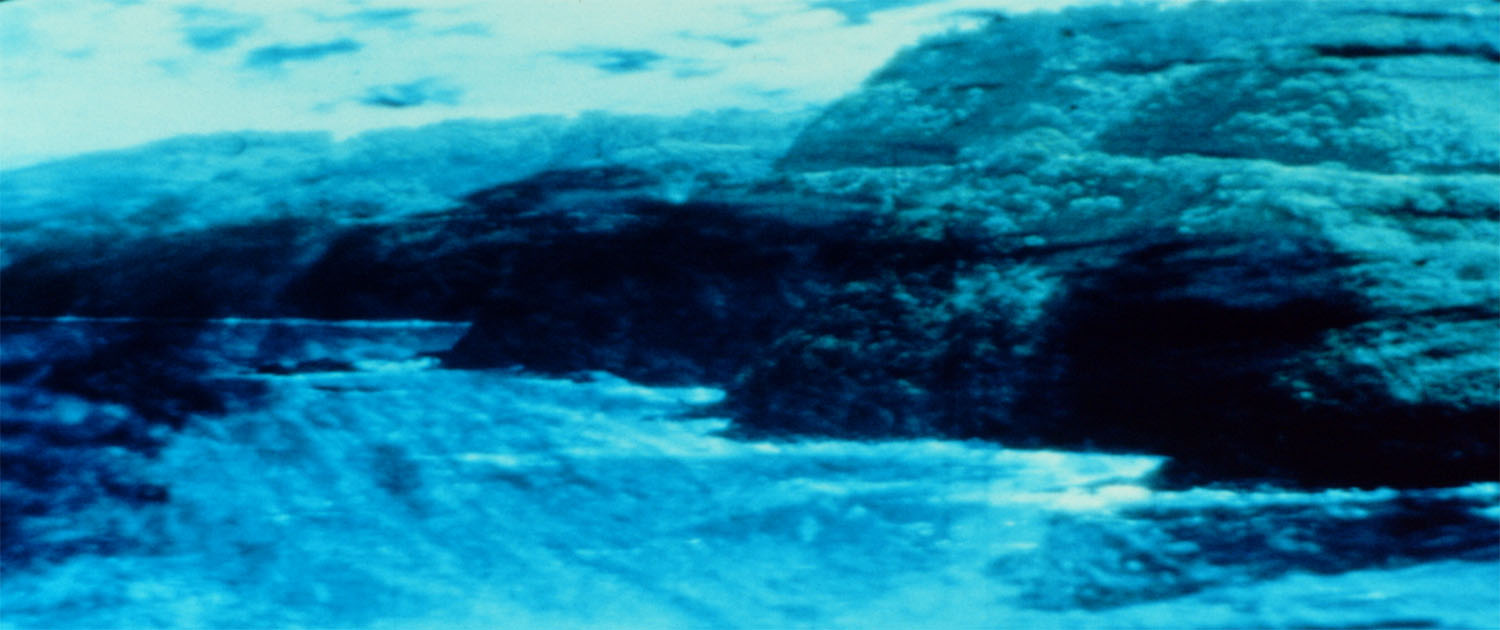
earthearthearth (2021 / 35mm / color / sound / 1S / 30' 00)
Dawn breaks where land is flesh
And bones’ echoes;
You’ve lived through extinctions –
Stars, skies, sand and seas;
Future is catching us up at last,
And all the dead are ahead of us.
Production: Daïchi Saïto, Oona Mosna
Cinematography, editing : Daïchi Saïto
Sound improvisation: Jason Sharp
Dawn breaks where land is flesh
And bones’ echoes;
You’ve lived through extinctions –
Stars, skies, sand and seas;
Future is catching us up at last,
And all the dead are ahead of us.
Production: Daïchi Saïto, Oona Mosna
Cinematography, editing : Daïchi Saïto
Sound improvisation: Jason Sharp

All Artists︎︎︎
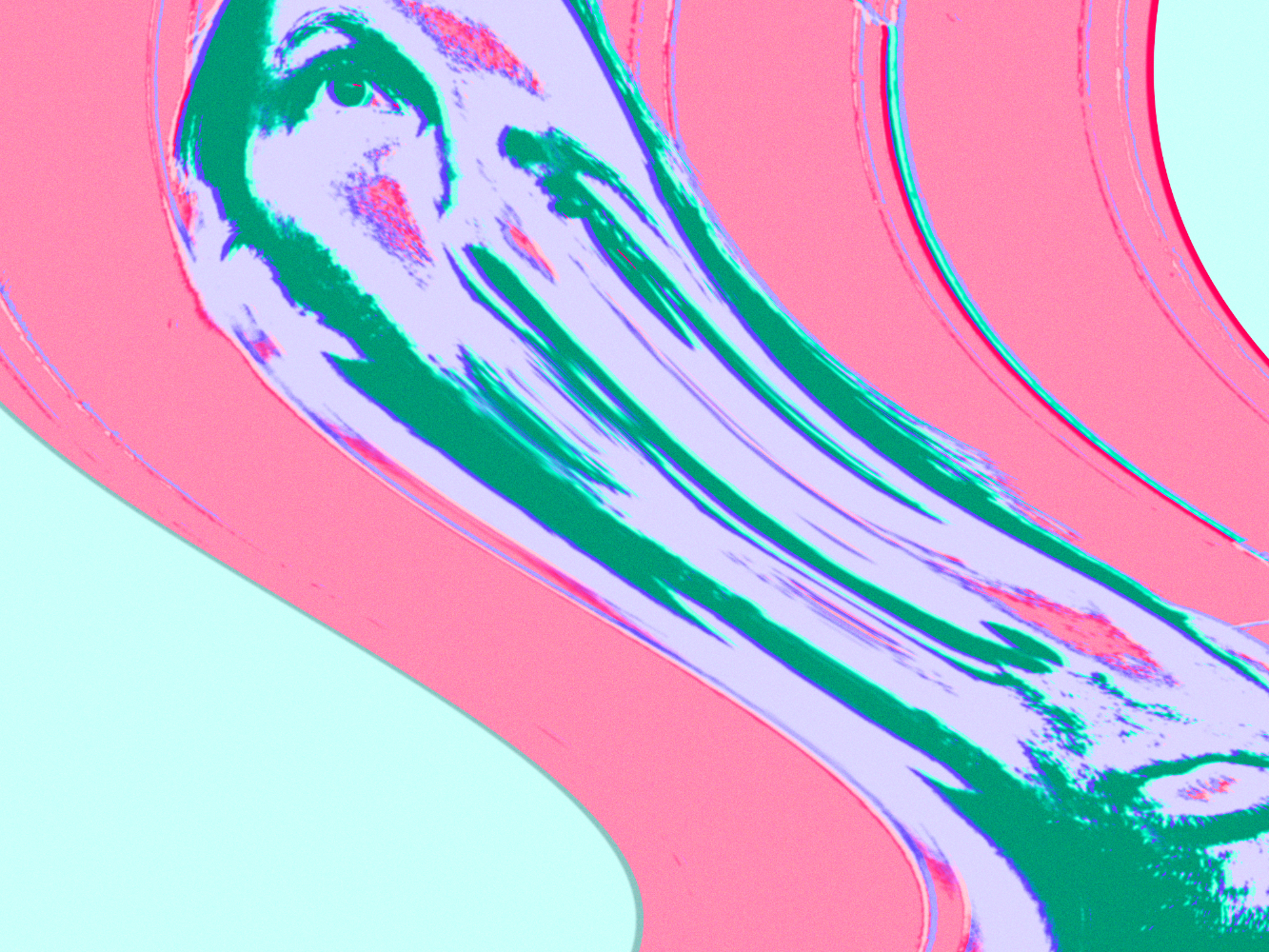
Tomutonttu
︎bandcamp︎︎︎
Jan Anderzén is a Tampere based artist who makes textile art, mosaics, drawings (together with robots), prints, sound sculptures, records and performances. He has shown his work in Christchurch, Beijing, Mänttä and other places. Jan wants to keep his art fresh by learning and developing new working methods, by reacting to changing technologies and by staying open to many ways of collaboration. Jan keeps searching beauty in the uncertain and the strange and he is not afraid of colours. He conciders art to be an activity with unpredictable powers.
For the past 27 years Jan Anderzén has been the main pilot of the band Kemialliset Ystävät. Tomutonttu is a creature who looks after all the dust and in solo mode Anderzén makes the music of Tomutonttu audible.
Jan Anderzén is a Tampere based artist who makes textile art, mosaics, drawings (together with robots), prints, sound sculptures, records and performances. He has shown his work in Christchurch, Beijing, Mänttä and other places. Jan wants to keep his art fresh by learning and developing new working methods, by reacting to changing technologies and by staying open to many ways of collaboration. Jan keeps searching beauty in the uncertain and the strange and he is not afraid of colours. He conciders art to be an activity with unpredictable powers.
For the past 27 years Jan Anderzén has been the main pilot of the band Kemialliset Ystävät. Tomutonttu is a creature who looks after all the dust and in solo mode Anderzén makes the music of Tomutonttu audible.
All Artists︎︎︎
Sandra Lahire
Sandra Lahire was born in 1950. She studied Philosophy at the University of Newcastle-on-Tyne (BA), Fine Art Film at St Martins School of Art (BA 1984) and Film & Environmental Media at the Royal College of Art (MA 1986).
In her beautifully crafted films, fragments of dazzling violence were cut and stitched together to produce a dreamscape of images that bombarded the senses, carrying the spectator in and out of bodies, across time and space, into haunted and haunting worlds. In the tradition of Frida Kahlo and Leonor Fini, who were two of her favourite painters, and Sylvia Plath, the poet who inspired her last films, Lahire created a filmic world of almost surreal intensity. Her work, central to the post-1970s movement of independent cinema, also seems certain to take up its place as part of this earlier tradition of painting and writing to which she gave new life.
Her films have been shown nationally and internationally at cinemas and festivals including Creteil, Locarno, Berlin, Montreal, Sao Paolo, Turin, Jerusalem, Australia and the Philippines. Writings include Lesbians in Media Education published in Visibly Female (ed Hilary Robinson, Camden Press 1987) and articles for Undercut. She also wrote a musical score for Lis Rhodes’ film Just About Now.
She passed away in 2001.
In her beautifully crafted films, fragments of dazzling violence were cut and stitched together to produce a dreamscape of images that bombarded the senses, carrying the spectator in and out of bodies, across time and space, into haunted and haunting worlds. In the tradition of Frida Kahlo and Leonor Fini, who were two of her favourite painters, and Sylvia Plath, the poet who inspired her last films, Lahire created a filmic world of almost surreal intensity. Her work, central to the post-1970s movement of independent cinema, also seems certain to take up its place as part of this earlier tradition of painting and writing to which she gave new life.
Her films have been shown nationally and internationally at cinemas and festivals including Creteil, Locarno, Berlin, Montreal, Sao Paolo, Turin, Jerusalem, Australia and the Philippines. Writings include Lesbians in Media Education published in Visibly Female (ed Hilary Robinson, Camden Press 1987) and articles for Undercut. She also wrote a musical score for Lis Rhodes’ film Just About Now.
She passed away in 2001.
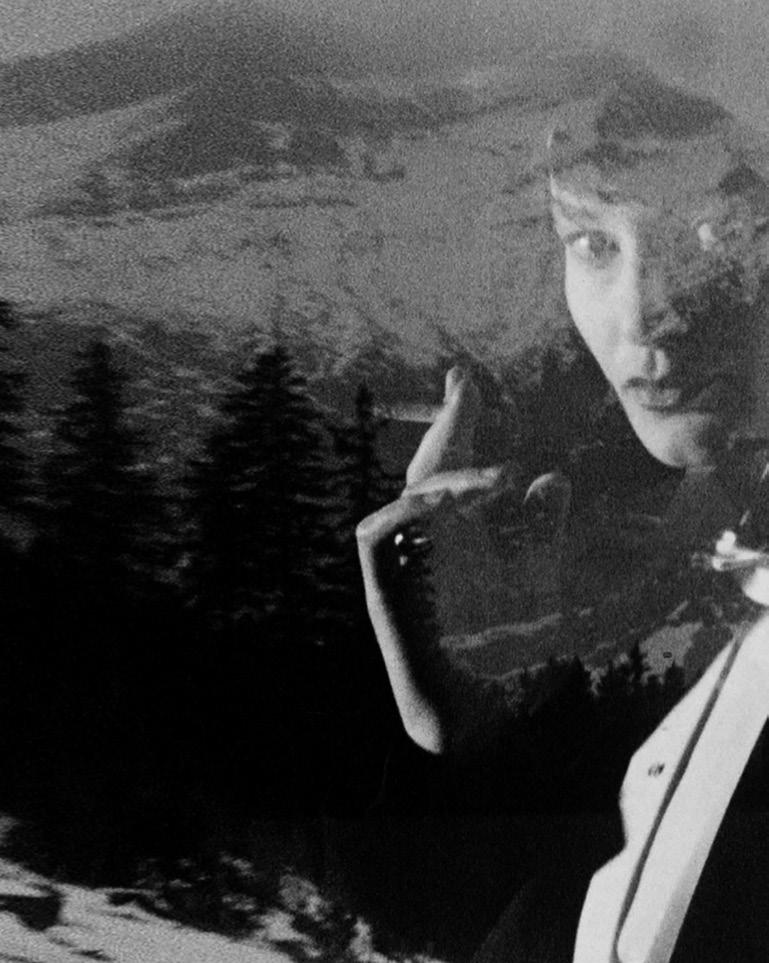
Arrows (1984, 15 minutes, DCP)
Arrows uses a combination of live action and rostrum work to communicate the experience of anorexia and to analyse the cultural causes of the condition. 'I am so aware of my body', we are told on the soundtrack, whilst images of caged wild birds are intercut with images of the rib cage of the film's subject, the filmmaker herself. Taking the camera into her own hands, and revealing this process to the spectator by using a mirror, the filmmaker shows herself in control of this representation of a woman's body. The film ends with Sylvia Plath’s poem The Thin People which speaks of people who starve themselves, and people who are actually deprived, locating the condition of anorexia firmly in western patriarchal culture.
Arrows uses a combination of live action and rostrum work to communicate the experience of anorexia and to analyse the cultural causes of the condition. 'I am so aware of my body', we are told on the soundtrack, whilst images of caged wild birds are intercut with images of the rib cage of the film's subject, the filmmaker herself. Taking the camera into her own hands, and revealing this process to the spectator by using a mirror, the filmmaker shows herself in control of this representation of a woman's body. The film ends with Sylvia Plath’s poem The Thin People which speaks of people who starve themselves, and people who are actually deprived, locating the condition of anorexia firmly in western patriarchal culture.
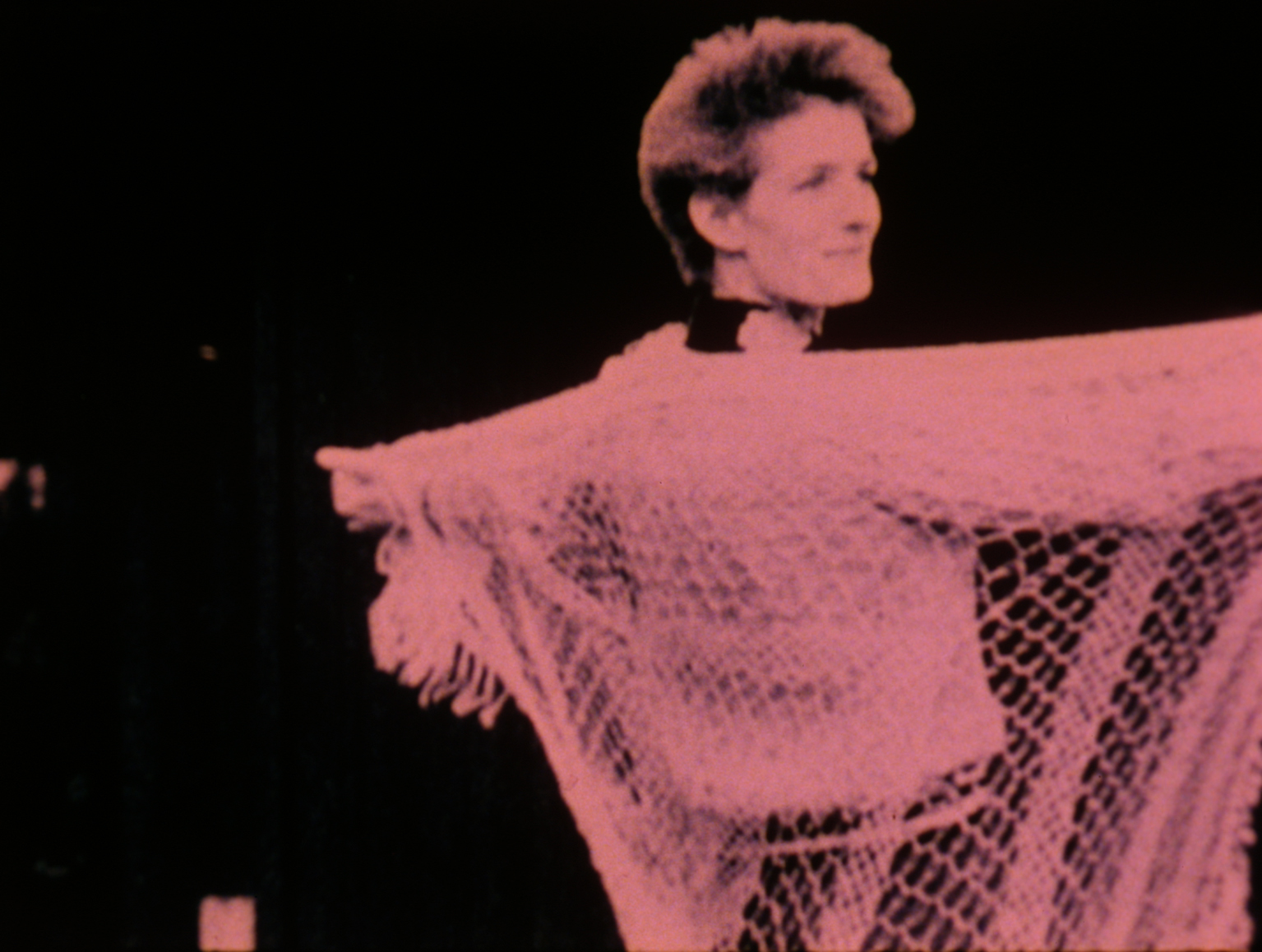
Terminals (1986, 18 minutes, Colour, Stereo, 4:3, DCP)
Terminals is a stream-of-consciousness collage, which asks us to look at and question the dangers of technological advances and nuclear power.
“The ‘work faster’ ethic is written on the door to the terminals. Hazards to fertility or risks of cancer are not criteria in setting ‘acceptable’ levels of exposure to radiation at work. At the Visual Display Terminal, women are staring directly at a source of radiation. Bomb tests and waste disposal are the white man’s cancer imposed on the people of the Pacific.” – S.L.
Terminals is a stream-of-consciousness collage, which asks us to look at and question the dangers of technological advances and nuclear power.
“The ‘work faster’ ethic is written on the door to the terminals. Hazards to fertility or risks of cancer are not criteria in setting ‘acceptable’ levels of exposure to radiation at work. At the Visual Display Terminal, women are staring directly at a source of radiation. Bomb tests and waste disposal are the white man’s cancer imposed on the people of the Pacific.” – S.L.

Lady Lazarus (1991, 25 minutes, B&W / Colour, opt, 4:3, DCP)
Sylvia Plath introduced her ‘Lady Lazarus’ reading by saying: “The speaker is a woman who has a great and terrible gift of being reborn. The only trouble is, she has to die first. She is the phoenix… She is also just a good plain resourceful woman.” In this film Lady Lazarus is a woman irresistibly drawn towards Plath’s voice. She becomes a medium for Sylvia, as in a seance, as the film travels between Massachusetts and Camden, on actual locations of the poet.
Lady Lazarus explores a cinematic alphabet for Plath’s own readings of her poetry and extracts from an interview given just before her death. The film provides an anchor for her macabre humour; a carousel of images in windows; an atmosphere of constant metamorphosis. – S.L.
“Lahire’s Lady Lazarus breathes life into Plath and her poetry. The poet’s ripe voice and the filmmaker’s kaleidoscope of rich images are poignantly combined in this memento mori from one rare talent to another.” – Lizzie Francke, Women Make Movies catalogue ’92.
Sylvia Plath introduced her ‘Lady Lazarus’ reading by saying: “The speaker is a woman who has a great and terrible gift of being reborn. The only trouble is, she has to die first. She is the phoenix… She is also just a good plain resourceful woman.” In this film Lady Lazarus is a woman irresistibly drawn towards Plath’s voice. She becomes a medium for Sylvia, as in a seance, as the film travels between Massachusetts and Camden, on actual locations of the poet.
Lady Lazarus explores a cinematic alphabet for Plath’s own readings of her poetry and extracts from an interview given just before her death. The film provides an anchor for her macabre humour; a carousel of images in windows; an atmosphere of constant metamorphosis. – S.L.
“Lahire’s Lady Lazarus breathes life into Plath and her poetry. The poet’s ripe voice and the filmmaker’s kaleidoscope of rich images are poignantly combined in this memento mori from one rare talent to another.” – Lizzie Francke, Women Make Movies catalogue ’92.
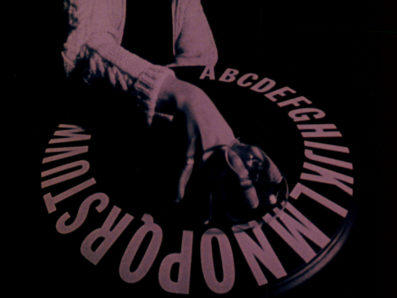
Night Dances (1995, 15 minutes, Colour, Stereo, 4:3, DCP)
“Night Dances is for my mother, who died whilst helping me to make this piano musical. The Dance of Death is bound to life – Lechaim – as we whirl together by Hebrew gravestones. A dreaming woman is ferried through our decaying city. This is the age of the Personal Computer – the Private Catacomb for the switched-on elite. Its dark doorways are for the wandering homeless… true survivors.”
– S.L.
“Night Dances is for my mother, who died whilst helping me to make this piano musical. The Dance of Death is bound to life – Lechaim – as we whirl together by Hebrew gravestones. A dreaming woman is ferried through our decaying city. This is the age of the Personal Computer – the Private Catacomb for the switched-on elite. Its dark doorways are for the wandering homeless… true survivors.”
– S.L.

All Artists︎︎︎
SOLA Post-Festival Club
Originally this event should have been organized
4th of May 2022, but due to the Helsinki city
workers strike it was cancelled. We will now
have the exact same lineup at the same place
Tue 24th of January 2023!
Oodi Library Maijansali
︎Tue 24.1.2023
︎18-20
Free of charge! 0 euros
On Tuesday 24th of January we celebrate the previous SOLA festival with a free of charge program! The main festival took place at WHS Theater Union 13th-14th of May.
In Oodi will have a selected short films of the renowned Finnish experimental film maker Saara Ekström and a musical performance by Ilpo Numminen and a live-art performance by Minerva Juolahti.
In Oodi will have a selected short films of the renowned Finnish experimental film maker Saara Ekström and a musical performance by Ilpo Numminen and a live-art performance by Minerva Juolahti.
Minerva Juolahti: erottuminen(–)
The performative gesture approaches the processes of differentiation and non-differentiation through body and space. The work explores how sound and image can create and disclose spaces, on the other hand make them fade out, blend into each other.
Esityksellinen ele lähestyy erottumisen sekä ei-erottumisen prosesseja kehollisuuden ja tilan kautta. Teos tutkii sitä, miten ääni ja kuva voivat toisaalta luoda ja tuoda esiin tiloja, toisaalta häivyttää niitä.

Ilpo Numminen
Synthhead Ilpo Numminen has been blasting socks off with his hypnotic cosmic comps for years now. Ilpo’s unabashed love for krautrock inflects his playful and decidedly spaced-out musiikkia, most notably on his latest release on the venerable Lal Lal Lal label lovably titled I Guess You Could Call This A Long Play. Ecstatic delights to warm even the coldest of continental hearts!
For Oodi library Ilpo will give a introduction how to use modular synthesizer as an instrument, an especially the hosted in one of the studios in the library. After the presentation we will hear a special set using only the Oodi library’s modular synthesizer!
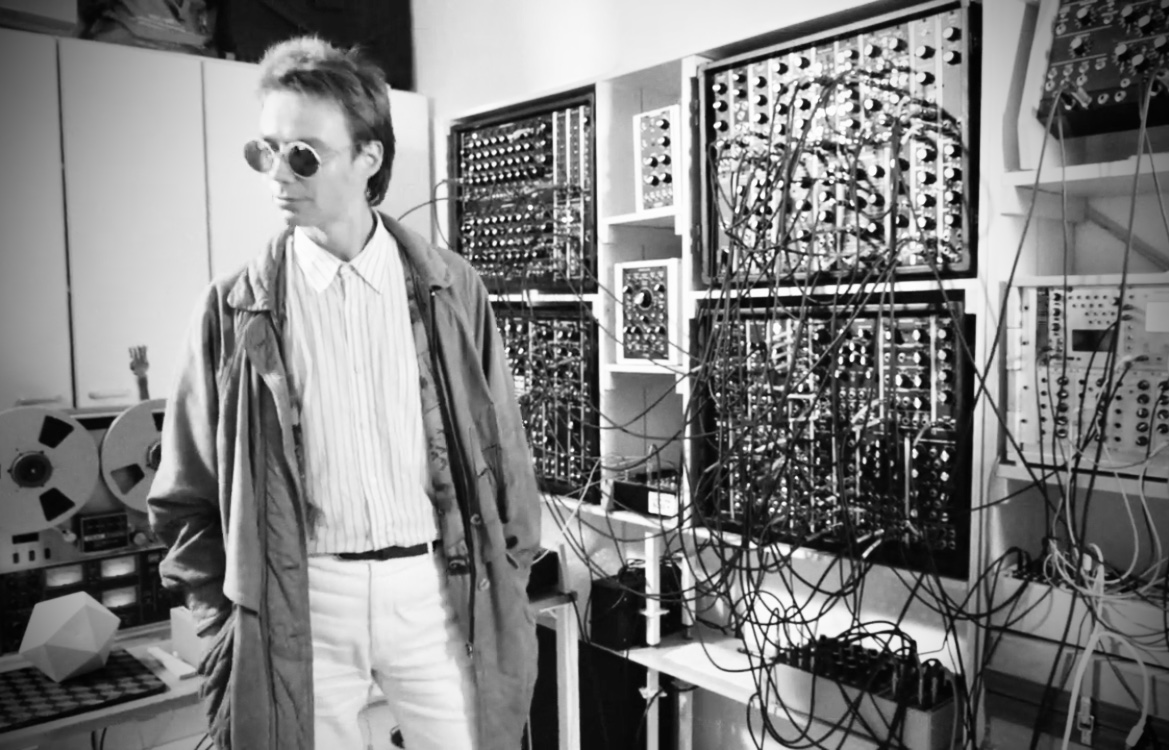
Saara Ekström
Saara Ekström works in film, photography, text and installation. Chronotopes where time and place densify, time that nurtures and erodes, the ambivalent desire to both remember and forget are at the core of her art. Ekström’s work has been shown extensively in various museums and festivals in Europe, the Americas and Asia. She received the Finnish media art prize AVEK-award in 2018 and the prizes of SW Finland in 2017, Finnish Art Society in 1995 and the Aboa prize in 1994. She has been the Helsinki Festival Artist in 2005 and was nominated for both Ars Fennica and Carnegie Art Award prizes in 2010.
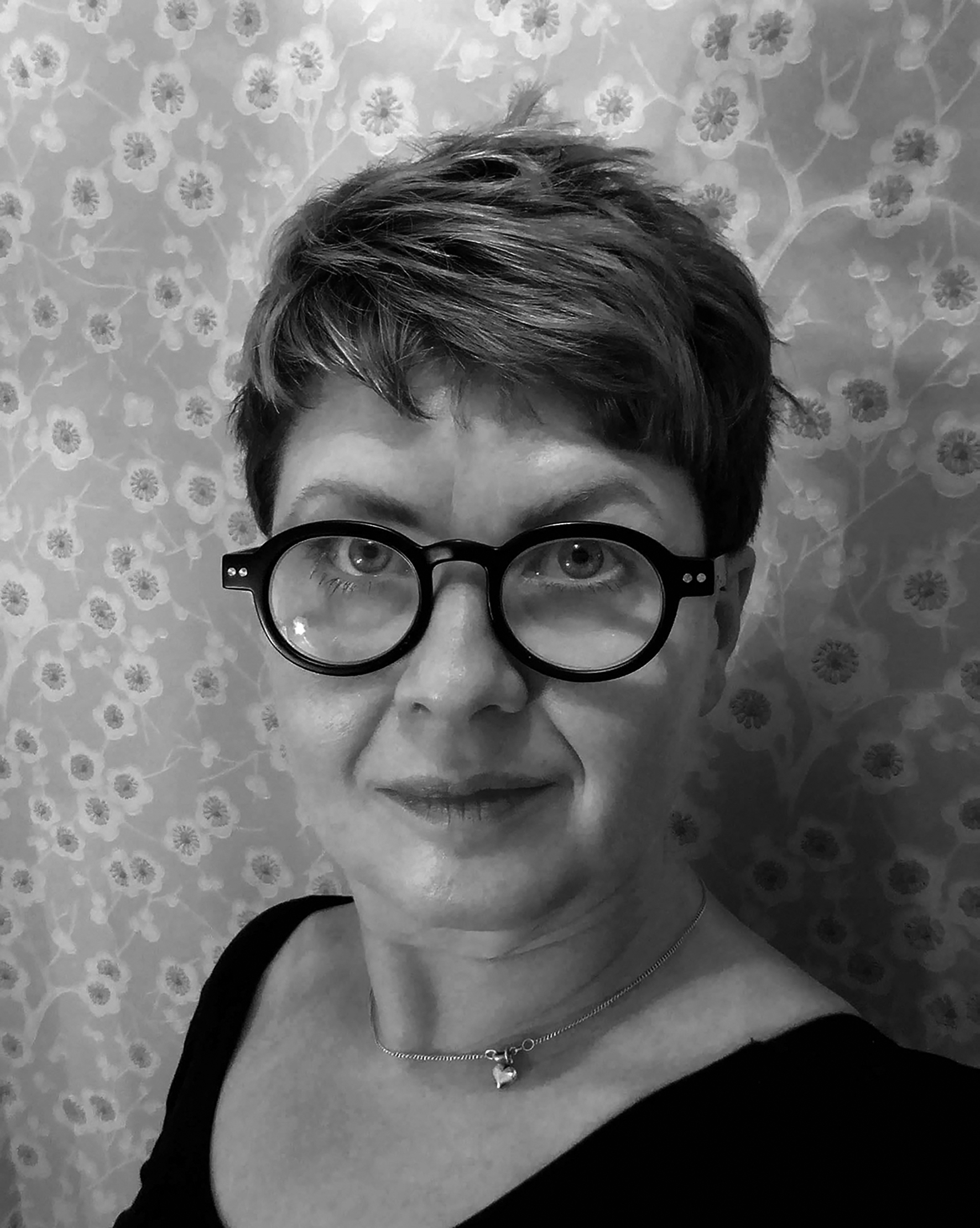
Saara Ekström: Shadow Codex (2021, HD, 12:30)
Filmed at the abandoned facilities of Turku County Prison (1835–2007), Shadow Codex documents the layers of messages drawn, burned and scratched on cell walls. The markings are pathways to the shadows of an individual’s psyche and expose an underbelly which a society both generates and hides. The 8mm film becomes the codex of a collapsed civilization and evidence of a forbidden zone in the centre of the city. The flow of images is punctuated by John Cage’s (1912–1992) composition “Perilous Night” (1964), which has been called a journey to the dark side of the soul.
Filmed at the abandoned facilities of Turku County Prison (1835–2007), Shadow Codex documents the layers of messages drawn, burned and scratched on cell walls. The markings are pathways to the shadows of an individual’s psyche and expose an underbelly which a society both generates and hides. The 8mm film becomes the codex of a collapsed civilization and evidence of a forbidden zone in the centre of the city. The flow of images is punctuated by John Cage’s (1912–1992) composition “Perilous Night” (1964), which has been called a journey to the dark side of the soul.

Saara Ekström: Body All Eyes (2018, HD, 14:39)
Body All Eyes is a requiem for barren skies in which archaic myths of flying through time and space collide with a technological and pragmatic world. It shows a stratosphere of airplanes, drones and surveillance-satellites that are all-seeing and ever-present eyes – a privilege that once belonged only to gods and their messengers, the birds. In the 8mm split-screen film the supernatural, mechanical, corporal and transcendental confront and embrace each other. A masked acrobat, creating a performative exchange between human and animal, leads the viewer through a torrent of images into a mysterious world, that undulates in a weightless state between heaven and earth.
Body All Eyes is a requiem for barren skies in which archaic myths of flying through time and space collide with a technological and pragmatic world. It shows a stratosphere of airplanes, drones and surveillance-satellites that are all-seeing and ever-present eyes – a privilege that once belonged only to gods and their messengers, the birds. In the 8mm split-screen film the supernatural, mechanical, corporal and transcendental confront and embrace each other. A masked acrobat, creating a performative exchange between human and animal, leads the viewer through a torrent of images into a mysterious world, that undulates in a weightless state between heaven and earth.

Saara Ekström: Amplifier (2017, HD, 17:03)
Time inevitably moves from past to future, passing the present moment. Mankind encloses to time its marks, stains and ruins. On the verge of vast changes time acts abnormally. It leaks, folds and fractures, allowing things belonging elsewhere, to the otherworldly, topermeate itself. In the 8mm film the Helsinki Olympic Stadium represents a historical paradigm shift. Completed in 1938 the building outlines pure functionalist architecture and stands as a landmark for optimistic utopia and the oblivion on man's neglect of history.
Time inevitably moves from past to future, passing the present moment. Mankind encloses to time its marks, stains and ruins. On the verge of vast changes time acts abnormally. It leaks, folds and fractures, allowing things belonging elsewhere, to the otherworldly, topermeate itself. In the 8mm film the Helsinki Olympic Stadium represents a historical paradigm shift. Completed in 1938 the building outlines pure functionalist architecture and stands as a landmark for optimistic utopia and the oblivion on man's neglect of history.

All Artists︎︎︎



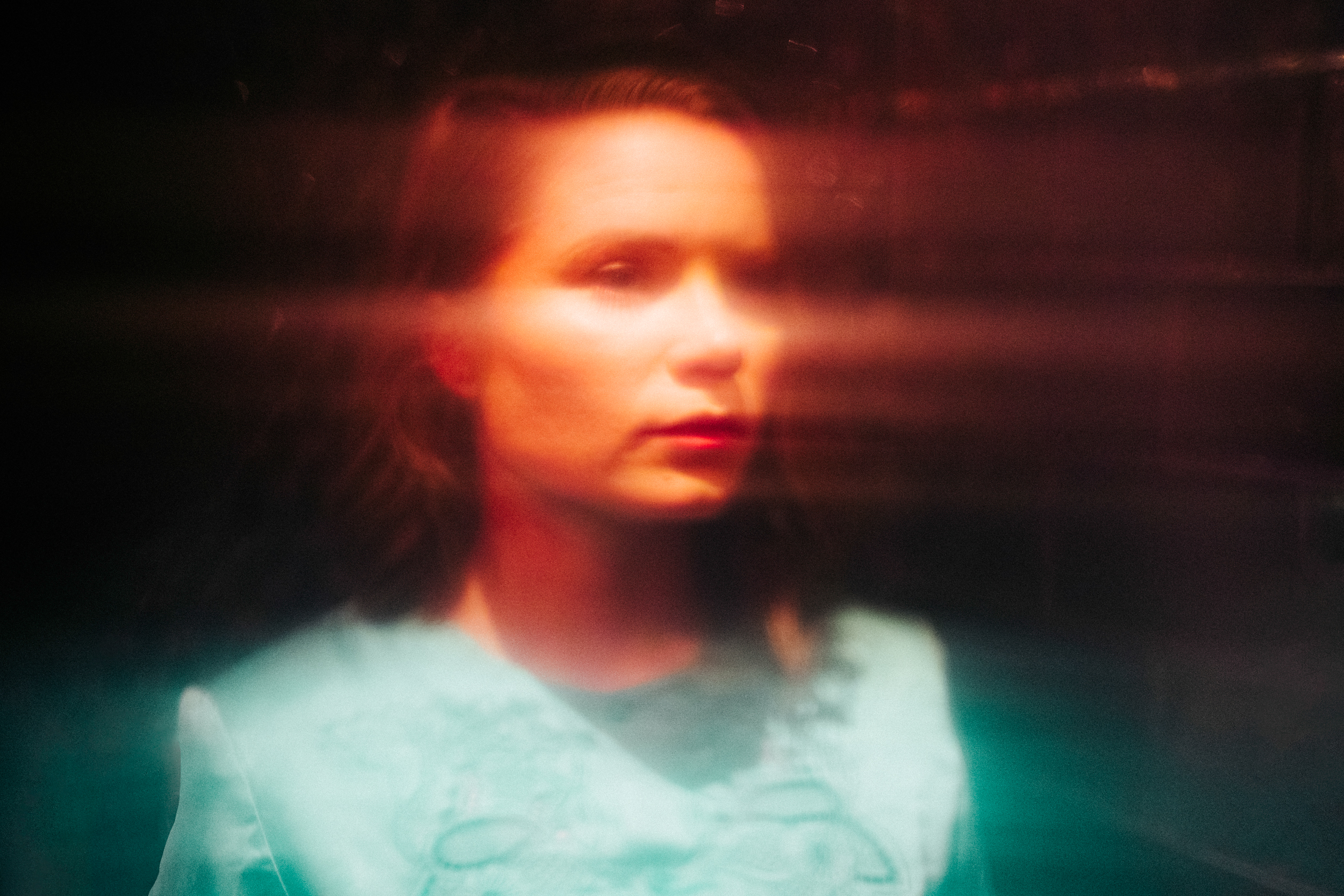 Minna Koskenlahti
Minna Koskenlahti
